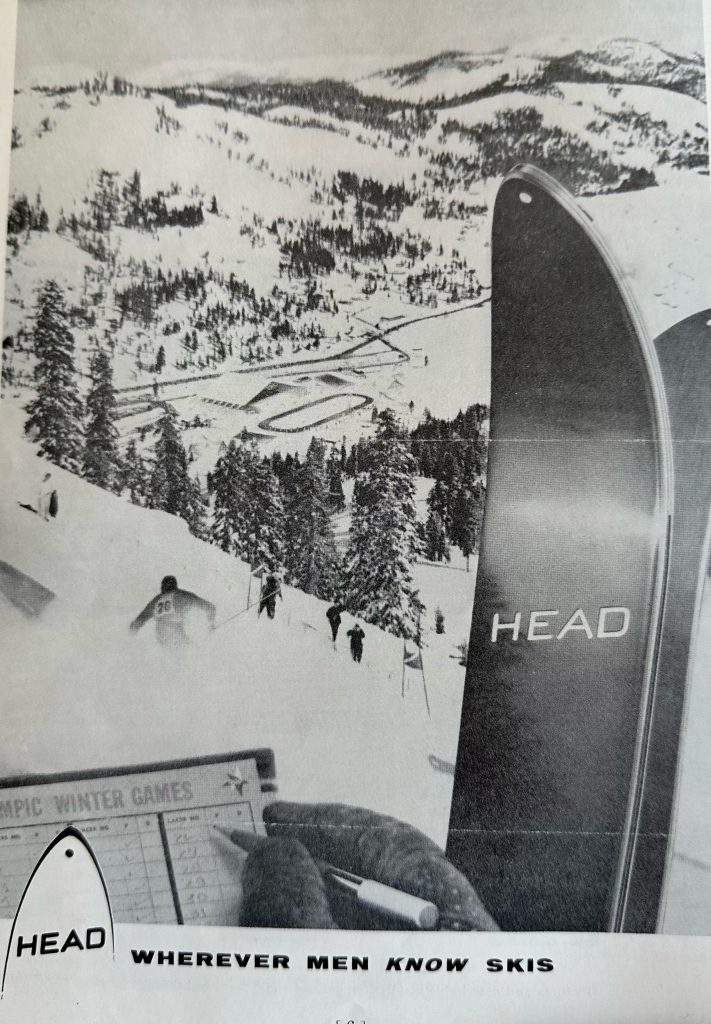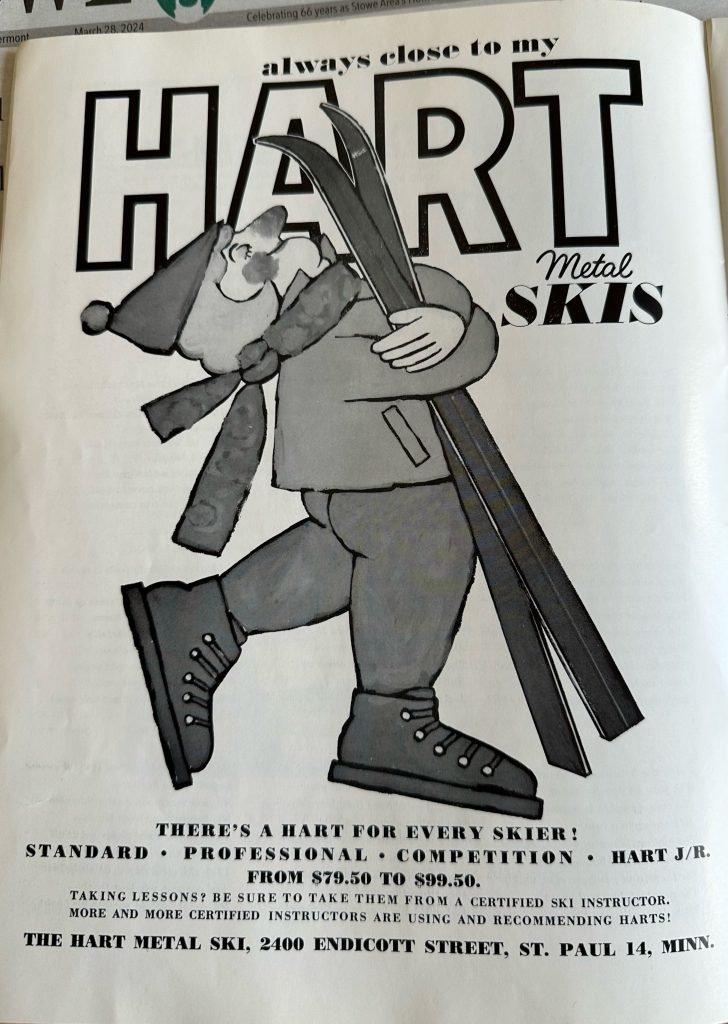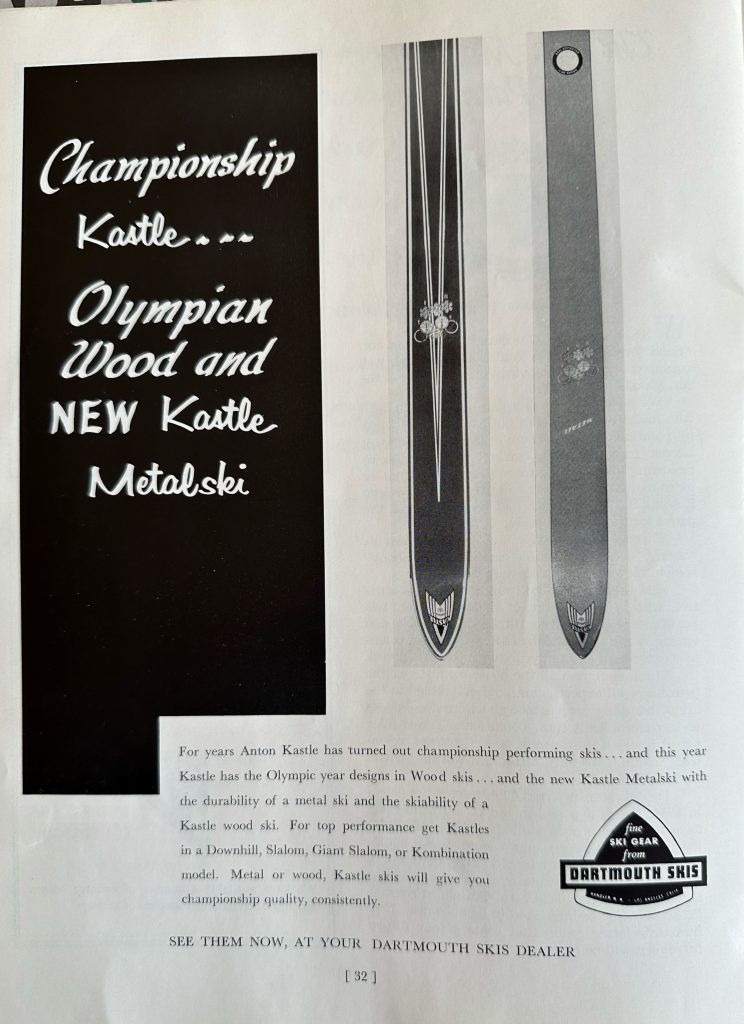The 1960 American International Ski Race program included articles on a variety of topics. One article was entitled “The Metal Ski” and I believe it was written by the editor Frank Springer-Miller since there was no other byline. The article indicates that people began experimenting with metal skis since about 1940 and without mentioning Howard Head by name, credits him with bringing the “scientific method” to the design of metal skis.
The article highlighted the advantages of the metal skis, “it turns much easier, is definitely superior in deep and rough snow, and requires little attention.” Although it also points out that since metal skis include hollow areas in the laminations, water can seep in which could possibly damage the laminations.
The program contains three full page ads featuring metal skis. The advertisement for Head skis is indicative of the differences between 1960 and today. The only text in the ad states “Wherever men know skis.” Hmmm?
Hart skis were far more egalitarian in their advertisement where part of the text says, “There’s a Hart for every skier!” Hart skis were the idea of the Holmberg brothers, Harry and Hartvig, of St. Paul, Minnesota. In fact, Hartvig’s nickname became the brand name. They introduced the first seamless, integrated metal edge in 1955.
The third ski advertisement was for Kästle skis. Unlike Head and Hart, Kästle made its name in wooden skis. Anton Kästle of Hohenems, Austria, made his first skis in 1924. WWII caused a pause in production, but the company started back up after the war. In the 1950s they were the skis to have, particularly in the racing community. Kästle would win 3 gold medals at the 1952 Olympics which were 50% of the golds awarded!
Kästle would struggle with the transition from wood to other materials until the mid-1960s when it introduced its CPM (Compound Plastic Metal) line of skis which restored the brand’s popularity.
The 1980s brought Kästle back to success on the World Cup circuit. This was due in large part to Pirmin Zurbriggen of Switzerland who skied for Kästle. He won 40 World Cup races and four overall World Cups during the 1980s. I was surprised to learn that he retired at age 27. Today racers compete into their 30s and I have every reason to think Zurbriggen would have added to his accomplishments had he continued competing.
Kästle’s racing success culminated in the 1988 Calgary Olympics where the brand accounted for 4 gold, 6 silver and 6 bronze medals.
Another part of the Kästle story is the number of “acquisitions” it has experienced. By that I mean, the number of times the company has been acquired by another company. One of those acquisitions by the clothing company Benetton in 1991 would lead to the brand suddenly disappearing in the late 1990s! A group of investors reacquired the brand and brought it back to its original home in Hohenems, Austria.
Another acquisition in 2018 has brought Kästle back to its racing roots. Ester Ledecká won the Super G on Kästles at the World Cup finals held a couple of weeks ago.
2024 marks the 100th anniversary of the Kästle brand and some of us are glad to see them back! I was a Kästle skier from 1978 to the mid-1990s and this season I’m enjoying a pair again!
As luck would have it, I saw the “Constructors Championship” results for the past World Cup season. That’s determined by the number of World Cup points scored on the various brands of skis. The winner was Head with 7760 points. Rossignol was second with 6595 points and Atomic third with 5590 points. Stoeckli had 2035 points in fourth which were pretty much accumulated by one skier, Marco Odermatt!




April 9, 2024 at 12:07 am
I remember when Kastle was being promoted back in the 1970’s as one of the “Team Austria” skis – along with Atomic, Blizzard, Fischer, and Kneissl. I think this was just some marketing program to promote the Austrian equipment manufacturers. Boots included Koflach, Technica, Kastinger and others. Skis in the 70’s came in some wild color schemes. Always love your equipment history posts.